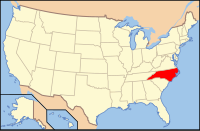Haywood County, North Carolina
| Haywood County, North Carolina | ||
|---|---|---|

Haywood County Courthouse, c. 1932
|
||
|
||
 Location in the U.S. state of North Carolina |
||
 North Carolina's location in the U.S. |
||
| Founded | 1808 | |
| Named for | John Haywood | |
| Seat | Waynesville | |
| Largest town | Waynesville | |
| Area | ||
| • Total | 555 sq mi (1,437 km2) | |
| • Land | 554 sq mi (1,435 km2) | |
| • Water | 0.9 sq mi (2 km2), 0.2% | |
| Population | ||
| • (2010) | 59,036 | |
| • Density | 107/sq mi (41/km²) | |
| Congressional district | 11th | |
| Time zone | Eastern: UTC-5/-4 | |
| Website | www |
|
Haywood County is a county in the western portion of the U.S. state of North Carolina. As of the 2010 census, the population was 59,036. Its county seat and largest city is Waynesville.
Haywood County is part of the Asheville, NC Metropolitan Statistical Area.
The county was formed by European Americans in 1808 from the western part of Buncombe County. It was named for John Haywood, who served as the North Carolina State Treasurer from 1787 to 1827.
In 1828 the western part of Haywood County became Macon County. In 1851 parts of Haywood and Macon counties were combined to form Jackson County.
The last shot of the Civil War east of the Mississippi was fired in Waynesville on May 9, 1865, when elements of the Thomas Legion (Confederate) skirmished with the 2nd NC Mounted (Union). A monument is situated on Sulphur Springs Road in Waynesville.
According to the U.S. Census Bureau, the county has a total area of 555 square miles (1,440 km2), of which 554 square miles (1,430 km2) is land and 0.9 square miles (2.3 km2) (0.2%) is water.
The Pigeon River originates in Haywood County. It is the only county in North Carolina that all water flows out while none flows in.
Haywood County is situated amidst the Blue Ridge Mountains and contains parts of several major subranges of the Blue Ridge, namely the Great Smoky Mountains in the west and the Plott Balsams and Great Balsam Mountains in the south. Notable peaks in the county include Cold Mountain, at 6,030 feet (1,840 m), Mount Sterling, at 5,835 feet (1,779 m), and Richland Balsam, at 6,410 feet (1,950 m) in elevation. Mt. Guyot, the county's highest point at 6,621 feet (2,018 m), is the 4th highest mountain east of the Mississippi River. Black Balsam Knob, in the Great Balsam Mountains in the southeastern section of the county, is the highest grassy bald in the entire Appalachian range. Haywood County is believed to be the highest county (by mean elevation) east of the Mississippi River, with a mean elevation of 3600 feet (1095m).
...
Wikipedia

